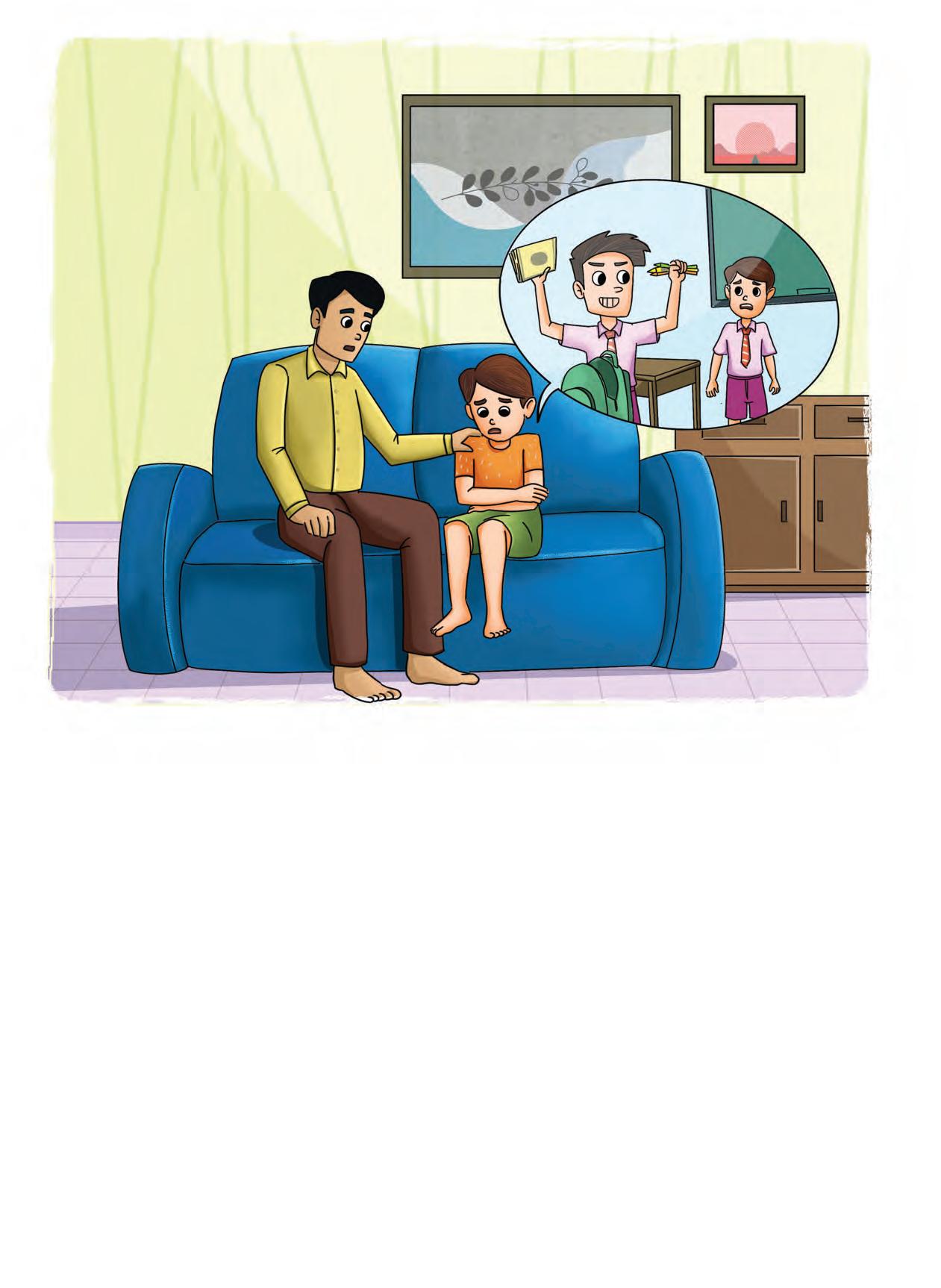

Achieve Fluency in Verbal Communication

Get access to animated learning videos, interactive quizzes, projects and more — all on the Uolo Learn app!




Get access to animated learning videos, interactive quizzes, projects and more — all on the Uolo Learn app!
Achieve Fluency in Verbal Communication

Academic Authors: Kashika Parnami, Sneha Sharma, Simran Singh, Arpit Agarwal, Laraine O’Connell
Creative Directors: Bhavna Tripathi, Mangal Singh Rana, Satish
Book Production: Rakesh Kumar Singh
Project Lead: Chandani Goyal
VP, Learning: Abhishek Bhatnagar
All products and brand names used in this book are trademarks, registered trademarks or trade names of their respective owners.
© Uolo EdTech Private Limited
First edition 2026
This book is sold subject to the condition that it shall not by way of trade or otherwise, be lent, resold, hired out, or otherwise circulated without the publisher’s prior written consent in any form of binding or cover other than that in which it is published and without a similar condition including this condition being imposed on the subsequent purchaser and without limiting the rights under copyright reserved above, no part of this publication may be reproduced, stored in or introduced into a retrieval system, or transmitted in any form or by any means, electronic, mechanical, photocopying, recording or otherwise, without the prior written permission of both the copyright owner and the above-mentioned publisher of this book.
Book Title: Speak 2.0 6
ISBN: 978-93-89057-11-9
Published by Uolo EdTech Private Limited
Corporate Office Address: 91Springboard, 3rd Floor
145, Sector 44, Gurugram, Haryana 122003
CIN: U74999DL2017PTC322986
Printed by: Kumar Offset Printer
Illustrations and images: www.shutterstock.com, www.stock.adobe.com and www.freepik.com
All suggested use of the internet should be under adult supervision.
In the age of globalisation and unprecedented technological advancement, English stands as a universally comprehensible medium of communication. It has evolved into one of the essential tools that learners require to thrive in today’s world and secure their future. Studies from across the globe show that English communication skills significantly impact on career prospects and lifelong learning.
Functional and fluent communication skills in English, encompassing the crucial facets of LSRW (Listening, Speaking, Reading and Writing), are pivotal to children’s knowledge acquisition, intellectual, socio-emotional development and lifelong learning.
In particular, robust listening and speaking skills not only form the bedrock of the language learning process but also pave the way for enhanced reading and writing capabilities. Yet, the majority of educational efforts prioritise teaching reading and writing from the very outset, sometimes neglecting listening and speaking skills. These foundational skills are often overlooked in educational institutions due to high pupil-teacher ratios, lack of opportunities to express themselves in English, and most significantly, a lack of structured and dedicated class time for honing these skills.
It is within this context that Uolo Speak 2.0 has been introduced as a groundbreaking English program tailored for learners in pre-primary to grade 8, with a special emphasis on English listening and speaking. In alignment with the National Education Policy (NEP) of 2020 and the learning outcomes set forth by the National Council of Educational Research and Training (NCERT), the books comprise 12 chapters on essential functional skills, with the last three advantage chapters to be used at the teacher’s discretion, depending on learners’ readiness.
The Speak 2.0 book serves as the classroom-based avenue for developing functional speaking skills. The book contains teacher-led English speaking and listening activities that adhere to the highly recommended and research-based teaching-learning method known as the Gradual Release of Responsibility (GRR). This approach systematically guides learners to master the targeted competencies. Through these activities, learners engage in high-quality, age-appropriate and experiential tasks that foster confidence and fluency in English. The accompanying Teacher Manual provides in-depth implementation plans for these activities.
AI lies at the heart of Speak 2.0, powering digital experiences that make learning English speaking dynamic and personalised. The package comes with digital content, provided free of cost, to ensure a seamless and holistic learning experience for children.
The mobile interface ensures consistent practice of functional English skills, while learners participate in speaking tasks enriched with AI-based evaluation and real-time feedback. Acting as a smart companion, AI guides pronunciation, sharpens usage, and enhances accuracy, encouraging learners to practise with confidence. With this seamless blend of AI-driven practice and feedback, learners steadily build fluency and gain the confidence to express themselves effectively in everyday communication.
Uolo Speak 2.0 offers a potent, captivating and unique learning experience for learners. It embodies a pragmatic, results-oriented approach to cultivating indispensable functional English skills required for the 21st century. We extend our warmest wishes to all educators, parents and learners as they embark on this exciting journey with Uolo Speak 2.0, filled with fun and joyful experiences.

Dr Laraine O'Connell
D. Litt., English, North West University, South Africa
I am a veteran English teacher and lecturer, with a great love for English and for teaching. I have taught English and trained teachers over many years. I live in South Africa and it is a wonderful experience working with a company promoting the learning of English in India.
Welcome to the Speak 2.0 journey!
The program is a thoughtfully crafted activities-based learning experience that builds students’ speaking skills in English. The program, with dedicated time and space within the classroom, becomes a platform to practise speaking and listening skills in everyday scenarios. These scenarios are created by way of teacher-led activities, which cater to specific competencies in English.
Coursebook
Speak on the Spot Activities
Prepared-Speaking Activities
Teacher Manual
Student and Teacher Apps
Talking Books
Listening and Speaking Projects
Interactive Practice Quizzes

The classroom program is augmented by the digital world, which is presented to the students through the UOLO App. The app includes projects that are closely associated with the activities in the coursebook. The projects allow a fear-free practice time to children at home and are AI evaluated. The app also includes quizzes in listening, speaking, reading and writing that can be done at home.

The National Education Policy (NEP) 2020, introduced by the Government of India, represents a transformative shift in the country’s education system. It aims to create a more holistic, dynamic and multidisciplinary approach to education. NEP 2020 focusses on fostering conceptual understanding, skills, values and competencies that align with the demands of the 21st century, while also preserving India’s rich cultural heritage. UOLO is fully committed to actualising the vision of NEP 2020 by meticulously adhering to its outlined recommendations.



1. Comprehension and understanding
2. 21st-century skills, values and dispositions
CompetencyBased Education
3. Application in real life




4. Holistic and integrated learning
5. Enjoyable and engaging
6. Collaborative and exploratory activities
NEP Pages 12, 17, 22
Teaching and Learning Pedagogy
7. Technology-based solutions

NEP Pages 3, 11, 12, 27
8. Assessment of core concepts and application skills Assessment
NEP Pages 12, 18, 22
Exposure to rich literature, as stories and poems, that demonstrate essential speaking behaviours and competencies.
1 2 3 4 5
Build mastery in new words usage, and expression, while also strengthening phonics skills to lay a strong foundation for reading and pronunciation.
1 2 7
Enhanced listening comprehension and elevated English learning experience through animations that bring each text to life.
1 5 7

Digital projects and supportive platforms that present English speaking opportunities in a fear-free environment.
2 3 4 5 7 8
Classroom activities and presentations that help build confident expression and language usage in everyday scenarios.
2 3 4 5 6 8
1 Comprehension and understanding
2 21st-century skills, values and dispositions
3 Application in real life
4 Holistic and integrated learning 5 Enjoyable and engaging 6 Collaborative and exploratory activities 7 Technology-based solutions
8 Assessment of core concepts and application skills

‘In the 21st century, language teaching must go beyond traditional approaches and must aim to enable students to use language skills in real-life contexts for a wide variety of purposes.’ (NEP, 2020)
According to Vygotsky and Krashen’s theory of second language teaching, language acquisition happens best when learners are engaged in purposeful and meaningful tasks in an anxiety-free, non-judgemental, communication-oriented, input-rich, supportive and stress-free environment, along with a lot of scaffolded practice. This approach to second language teaching is also highlighted by the NIPUN Bharat Mission document and NEP 2020.
In this context, the Speak 2.0 series, along with the learning activities designed in it, can play a crucial role in creating an input-rich environment, employing diverse avenues for speaking practice in a fear-free and non-judgemental setting, coupled with real-time feedback. The book has been developed based on the ‘Gradual Release of Responsibility’ (GRR) model— a teaching-and-learning model that has been widely recommended by the NEP 2020 and the NCF 2022-23. The GRR has been promoted by educational researchers and practitioners all over the world for its effectiveness in promoting student engagement and a deep understanding of content and skills.
The GRR model includes three steps, each one consecutively shifting the ‘responsibility’ from teachers to learners so that learners become independent users of the language.
I do: The teacher first provides explicit instructions and modelling that initiate the learning process.
We Do: As learners begin to grasp the content and skills, the teacher also begins to shift the responsibility to them, facilitating guided practice where the teacher and the learners participate collaboratively.
You Do: Finally, the learners take full ownership of their learning through independent practice and the application of the skills learnt in the program.
Based on this approach, there are three core instructional models on which the activities work (please refer to lesson plans in the Teachers' Manual for greater clarity). These are:
I do We do You do Listen Echo Express and Repeat (E&R)
Fully guided; Modelled speaking by the teacher
Collaborative; Shared speaking between the learners and the teacher Independent practice and application by the learners
To sum up, the programme has been created to do away with the fear of speaking in English among learners and allowing them to express themselves confidently in English in real-life situations.
The National Curriculum Framework for Foundational Stage (NCF) , released in 2023, is developed based on the vision of the National Education Policy (NEP) 2020, and to enable its implementation. The NCF provides guidelines for designing school syllabi and textbooks in India. It aims to improve the quality of education by making it more relevant, engaging, inclusive, and learner-centric. To achieve this, the NCF has articulated precise Learning Standards through well-defined Curricular Goals and Competency statements. These statements serve to harmonise the syllabus, content, pedagogical practices, and assessment culture, ensuring a cohesive and comprehensive educational experience. Curricular Goals: Curricular Goals are statements that give direction to curriculum development and implementation. They are derived from Aims and are specific to a Stage in Education. Competencies: Competencies are learning achievements that are observable and can be assessed systematically. These Competencies are derived from the Curricular Goals and are expected to be attained by the end of a Stage.












C-1.1 Converses fluently and meaningfully in different contexts
CG-1 Students develop oral language skills using complex sentence structures to understand and communicate abstract ideas.












C-1.2 Describes an outline of the material that has been read out and answers questions related to it












C-1.3 Summarises core ideas from the material that was read out























C-1.4 Demonstrates the ability to speak their reasoning coherently















C-1.5 Makes oral presentations (class debates, short welcome notes, anchoring of small events, short speech, and so on)
C-4.1 Uses knowledge of homophones, word roots, affixes, suffixes, synonyms, and antonyms
CG-4 Students acquire a more comprehensive range of words in various contexts (of home and school experience) and through different sources.
C-4.2 Discusses meanings of words and develops vocabulary by listening and reading a variety of texts or other content areas
1
2
3
Introducing Oneself Formally
Asking Questions and Responding
Describing an Event or Experience
4 Expressing Feelings and Emotions
5
Apologising for Mistakes
6 Giving Instructions
7
Stating Cause and Effect
8 Raising a Complaint
9 Giving a Short Speech
Answer questions related to oneself
Introduce oneself in a formal setup
Ask questions starting with what, where, why, when and how
Respond to questions using polite expressions
Describe an event/experience with a few details
Answer questions about an event/experience
Share personal feelings, ideas and emotions on a topic or event
Appreciate and respond to feelings of others on an issue
Admit and apologise for a mistake using polite and respectful language
Briefly explain what went wrong and suggest a way to make up for the mistake
Talk about the dos and don’ts for simple life events/activities
Give step-by-step instructions in order to guide someone or get something done
Identify and state the cause(s) of an event
Explain the effect(s) of an event
Raise a formal complaint using polite and clear language
Suggest a simple solution or plan of action to resolve the issue
Share short, motivational and catchy taglines/titles
11 Speaking Persuasively
Give a short and informative presentation on a topic
Ask and answer questions based on the presentation
Give a short speech on a topic of personal relevance 10 Making a Short Presentation
Identify the main idea and supporting arguments from an opinion
Speak persuasively in support or against of something 12 Participating in Group Discussions
Participate actively in a group discussion
Stay on the topic and extend the discussion in a respectful and coherent manner


Talking Book: Animated video of the text
Keywords: Keywords from the text with meaning and pronunciation
E-Speak 1: A series of three guided speaking projects on the mobile app
Gaming Zone 1 and 2: Fun activities aligned with the big skill

Talk Toolkit: learners with essential vocabulary and language structures for the targeted speaking competency










Speak on the Spot: Impromptu speaking activity to be done in the classroom
E-Speak 2: A short, open-ended, assessment-type project on the mobile app
Speaking prompts with no expectation of writing

Practise: Guidance on how to practise at home

Tips: Helpful points for better speaking





Reflection Journal: A template for reflecting on the achievement of the targeted outcome





Tell us something about yourself, Ananya.

Good morning! My name is Ananya Sharma. I am in Class 6 at Sunrise Public School. I love painting and reading storybooks.
Talking Book















What is the name of your pet? How are you?
Which is your favourite novel?








3
4
Interviewee: . (answer the third question)
You: Thank you so much for your time. I am so happy to finally meet you.
Interviewee: It was my pleasure. You asked some interesting questions. Good day. Bye!
Practise: Prepare for the interview. Practise asking questions with expression.
Present: Now, it’s time to present the interview to the class. Your teacher will be the interviewee and read the responses.


Begin your question with a Wh-word (What, Where, When, Which, How, Why).
Speak with appropriate expression and gestures. You can use some props to get into the role of an interviewer.
Provide your book to your teacher for him/her to read your responses.

In this chapter, I learnt to . New words I learnt:

Imagine you have gone to the market to buy some things. Which shops would you go to and what ‘wh’ questions would you ask?
How confident do I feel asking questions and responding to them?




How was your experience?
The competition was very tough. I felt proud and excited when my name was announced.
Talking Book








I called a teacher ‘Mummy’ by mistake
I shouted the wrong answer even before listening to the question
I felt when it happened.
embarrassed confused awkward worried shy nervous funny excited my friend dropped the whole water bottle on his lap
I tripped while going up to a stage I waved back at someone who wasn’t waving at me my shoe came off while running in a race
Overall, it was so funny, I still burst into laughter thinking about it.
3
Practise: Share your experience with your family and friends.
4
Present: Now, it’s time to share the funny incident with your classmates.



Speak clearly and with feeling.
Enact the experience, if you can.
Use props to share your experience, if possible.

In this chapter, I learnt to . New words I learnt: You participated in your school’s annual function. Describe your experience of performing on stage. It could be a dance, music or drama performance. Write in 3-4 sentences.


I worked so hard on my drawing, but no one noticed it. I just feel really sad.

It’s okay to feel that way. Talking about it helps— I’m here to listen.
Talking Book















No problem. You didn’t do it on purpose.

I’m really sorry, uncle. I dropped the jar by mistake.
Talking Book








That’s disappointing. What went wrong?
Thank you for being honest. How do you plan to correct this?




That sounds responsible. I’m glad you are taking steps to correct your actions.




What’s next?

Now, add the yellow and blue blocks on each side.
















Why did the food fall?
The waiter slipped, so all the food fell on the floor!














I am facing a problem with the constant power cuts in my area.








Good morning! . How can I help you today (name)
Oh, I understand.

Can you suggest any solution for this?





Yes, this can be improved by .
That is a nice idea! I’ll make sure it is done.

Thank you, Sir/Ma'am! That will really help us learn better.






I’ve always believed that if you work hard, you will definitely get the result.
What a speech!






Present: Present your speech in the class.


Speak clearly and with expression. Make eye contact with your audience.
Use an enthusiastic tone of voice and body language to keep the audience engaged.
In the end, you may ask the audience if they feel inspired.


In this chapter, I learnt to . New words I learnt:
Imagine your team won a competition in your school and you have been asked to give a winning speech. Write your speech in 4–5 lines and use a catchy tagline to start the speech.




Hello, everyone! Today, I will explain how the planets revolve around the sun.
Talking Book

Today, I will talk about…
First of all, let me…
Did you know that…?
Another important/ interesting…
To conclude, …
Can you please explain more about…?
Why/What do you think…?
That’s a good question. I think/ believe…

Today, I will talk about why saving water is important./ Today, I will talk about why following rules in school is important.
First of all, let me tell you how much waste we dump daily./ First of all, let me share a simple routine to stay healthy.
Did you know that bees can recognise human faces?/ Did you know that honey never spoils?
Another interesting fact is that some indoor plants can clean the air we breathe!/ Another important thing is that painting can reduce stress and improve focus.
To conclude, reading books is not just fun—it also makes us smarter!/ To conclude, recycling is a simple way to protect our environment.
Can you please explain more about communication skills?/ Can you please explain more about how robots are used in daily life?
What do you think would happen if there were no mobile phones?/ Why do you think playing outdoors is better than watching TV?
That’s a good question. I think we all must read newspapers daily./ That’s a good question. I believe practice and patience help us to get better.


Project 10A
Ansh answers his classmate, Ritika’s question: ‘What do you think are the alternatives to plastic?’. Listen and record it.
Project 10B
Your teacher asked you to prepare a short presentation on ‘Staying Healthy’, and Aarav decided to speak about healthy eating. Listen and record it.
Project 10C
Aarohi and Shruti are giving a presentation on deforestation. Aarohi began the presentation, and now Shruti will continue and conclude it. Listen to Shruti and record it.
Make SIX words of four or more letters from the word PRESENTATION.










Sure! When we play sports, we . Can you tell me one more benefit of sports in student life?
are constantly active, our blood flow is better
learn to manage our time well
2
3
Thank you so much for answering my questions!
can improve our focus and do better in studies have less stress and it makes us happy
Practise: Practise your lines before your family.
Present: Present confidently in front of the class.


Be confident while speaking. Make eye contact with your partner. Respond politely to the questions.

collaborate and partner with others to think and perform well learn to handle winning and losing gracefully

In this chapter, I learnt to . New words/phrases I learnt:
You have been asked to present your views on the Importance of Examinations. Write 4–5 sentences on it.

How confident do I feel in giving a presentation and also asking and answering questions about it? 1 I need help. 2 I think I can do it.
3 I feel confident.


Fruit cake is the best cake of all!











We’ve been sitting here for 10 minutes and still can’t decide what game to play!
How about we mix hide-andseek with a treasure hunt? Let’s call it ‘Hide the Treasure!’









Practise: Practise your lines in front of your family or friends. 3

Present: Present your views in the classroom. 4 Speak clearly and confidently. You can give your own answers. Treat everyone’s viewpoints with respect.



In this chapter, I learnt to


This SPEAK 2.0 book aims to systematically build English language skills in learners and enable them to verbally express themselves in real-world situations. Each chapter focusses on building specific English language competencies and weaves together activities that are research-based, age-appropriate, contextual, experiential and joyful. The activities adhere to the highly recommended and research-based teaching-learning method known as the Gradual Release of Responsibility (GRR), which has been endorsed by the NEP 2020 and the NCF 2022–23. Through the series, learners receive dedicated time and space within the classroom to express themselves in English which helps them in becoming confident speakers of the language.
• Activity-Based Learning: The book offers joyful experiential activities that build English communication competencies.
• Texts per the NEP 2020 Themes: The book has exciting and stimulating texts that pave the way for English communication activities.
• Tech Integration: The book works in sync with our digital component, where various other activities and projects are undertaken. Learner outputs are evaluated through an AI-based speech recognition engine.
• Teachers’ Manual: The book is complemented by the Teachers’ Manual that enables teachers to conduct each session effectively.
Uolo partners with K-12 schools to provide technology-enabled learning programs. We believe that pedagogy and technology must come together to deliver scalable learning experiences that generate measurable outcomes. Uolo is trusted by over 15,000+ schools across India, Southeast Asia and the Middle East.
ISBN 978-93-89057-11-9
